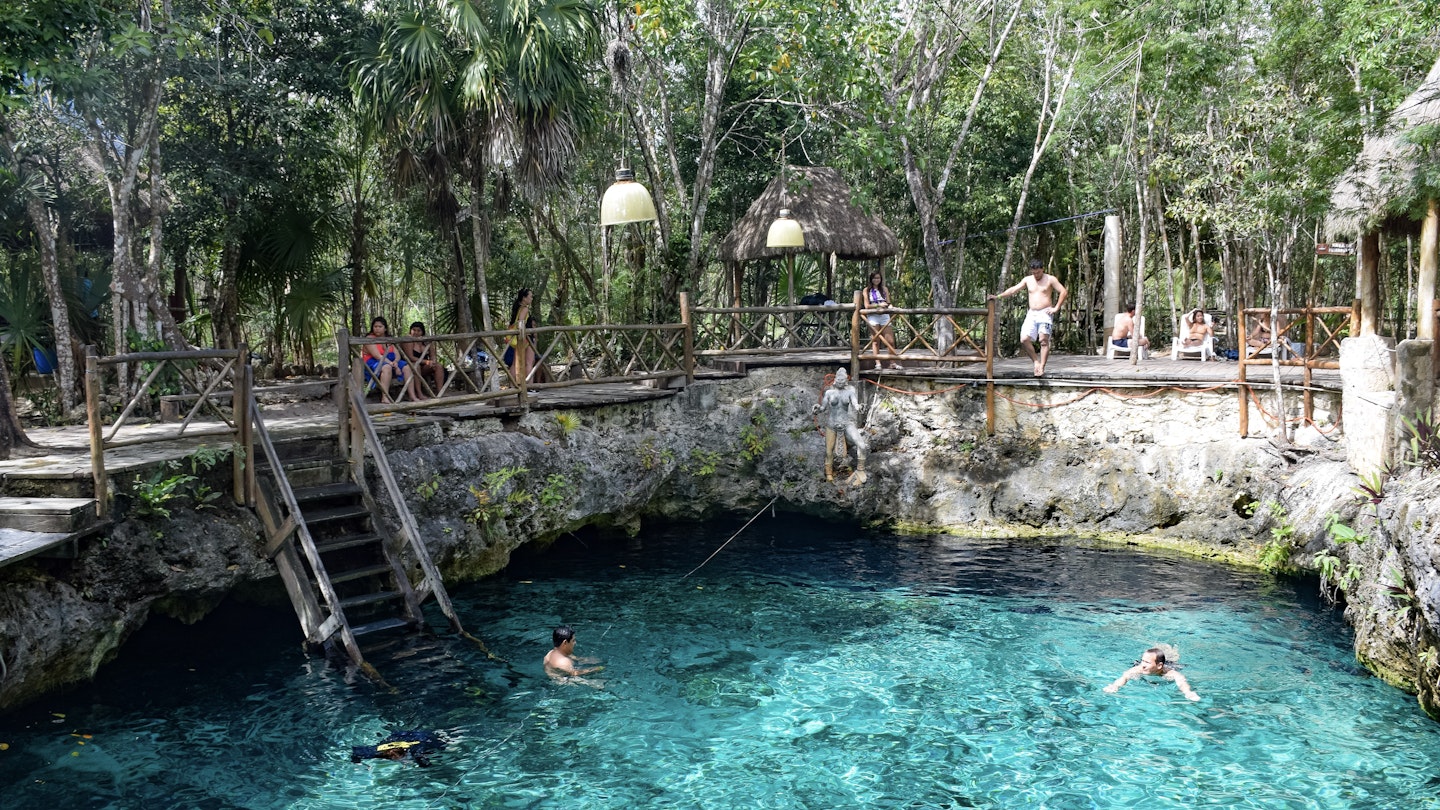Mexico’s Yucatán Peninsula boasts stunning beaches in Cancún, Playa Del Carmen, and Tulum. For those seeking respite from the sun, the region offers a mesmerizing underworld of turquoise pools where the ancient Mayans once sought to communicate with their gods.
The cenotes, natural swimming holes formed from the collapse of porous limestone bedrock, expose a magical subterranean world of crystal-clear waters. These sacred wells, revered by the Mayans, served as vital sources of water during dry periods—hence the name cenote, meaning “sacred well.”
Diving into these waters transports you to a realm dominated by giant tropical trees and dense vines that frame these natural pools, with shafts of sunlight breaking through and illuminating the water below.
Most cave cenotes feature fresh, pure water that has been meticulously filtered through the earth, offering astonishing visibility to spot fish amongst the plant life. Underwater enthusiasts will appreciate the high-definition clarity for perfect snapshots. Open-air cenotes also feature pristine waters, often enriched with algae that provide nourishing elements for the skin.
Note: Travel restrictions may apply during COVID-19. Please check for updates and adhere to government health protocols before planning your visit.
Cenote Yokdzonot, near Chichén Itzá
This hidden gem, Cenote Yokdzonot, lies just a short distance from the more famous cenote near the Mayan pyramids of Chichén Itzá. A mere ten minutes further and away from the crowds, you’re likely to find solitude in its pristine waters.
Here, you might encounter a few other swimmers or enjoy the serene experience of floating alone, accompanied only by the gentle hum of nature. Splendid vines intertwine overhead while hummingbirds flit by, completing this tranquil scene.
Admire the diligent efforts of local Mayan women, part of the Zaaz Koolen Haa cooperative, who maintain this cenote’s beauty. As you enter the water, notice the carefully laid stone paths, a testament to this cooperative’s spirit.

Cenote Dos Ojos, near Tulum
The name “Dos Ojos,” meaning “two eyes,” aptly describes the cenote’s two distinct pools: one bright blue and the other dark and cavernous. Though both pools are well-maintained, the darker option garners more attention for its unique snorkeling venture through lightless waters.
Here, you can rent diving gear, complete with flashlights to navigate the rocky terrain and observe impressive stalactites just overhead. While the tight spaces may not suit everyone, the adventure unveils beams of light penetrating the depths below, a perfect contrast to the nearby Tulum pyramids.
Additionally, the other cenote offers snorkeling opportunities in sunlit waters where relaxation comes naturally among the gently flowing currents. You may also enjoy strolling through the dry caves, spotting bats as they rest among the stalactites. Accessing Cenote Dos Ojos typically requires a car, taxi, or joining a tour.

Cenote Azul, near Tulum and Playa Del Carmen
With its local charm, Cenote Azul lacks the crowds and elaborate amenities found at larger parks. Here, you can enjoy a peaceful atmosphere reminiscent of an intimate theme park, where nearly everything is accessible.
The clean turquoise water invites exploration, with curious tropical fish swimming beneath the surface. This cenote accommodates visitors of all ages, providing opportunities for kids to leap from mini cliffs or for those preferring gentler waters to wade in shallow pools.
Local minivans, known as camiones, are available for hire from Playa Del Carmen or Tulum, allowing for easy access.

Cenote Samulá, near Valladolid and Chichén Itzá
Famed for its striking visuals, Cenote Samulá in Dzitnup captivates visitors with colored lights that pulsate through its subterranean cave, setting a moody stage for swimmers immersed in its refreshing waters. A glance upwards reveals long tree roots spilling down through a large opening in the cave ceiling.
Sunlight floods into the space, dramatically illuminating the blue waters while small fish swim around your feet and bats lazily flutter above. This dynamic environment reconnects you with nature in its most enchanting form, with rock paths guiding you down to the crystal depths.
Cenote Ponderosa, near Playa Del Carmen
Steeped in mystery, Cenote Ponderosa, also known as Jardín del Edén or “Garden of Eden,” has a rich historical background where Mayans sacrificed humans and dropped offerings into its depths. The cenote’s allure continues with its 15-meter depth inviting those adventurous enough to explore underwater caves for possible treasures or simply to enjoy its vibrant aquatic life.
The expansive cenote is partly sheltered by a rocky ceiling, inviting visitors to jump from heights (with caution) into pristine waters teeming with fish. Nestled at the bottom of a tree-lined valley, this cenote embodies the spirit of timelessness, echoing the ancient rituals of the Mayans.

Grutas de Loltún, near Chichén Itzá and Tulúm
For those who prefer to stay dry, the Grutas (caves) offer stunning glimpses of cenote formations without requiring a swim. The Grutas de Loltún stand as the largest caves in the Yucatán Peninsula, providing a remarkable journey through Mexico’s striking subterranean world.
Guided tours take you through a sprawling network of caverns adorned with ancient petroglyphs, intertwining roots and stunning stalagmites. The experience culminates in a symphony of sounds as you strike the geological formations, producing echoes that celebrate the history encapsulated within.

What to Bring for a Yucatán Cenote Adventure
When planning your visit, make sure to bring swimwear, water, sandals or flip-flops, and a towel, leaving valuables at home. It’s also essential to pack reef-safe sunscreen to protect the delicate ecosystem within the cenotes. Entrance fees generally hover around 200 pesos (approximately USD$10) per person, with many cenotes providing changing facilities and options for renting flashlights, life vests, and snorkeling equipment. Some venues even offer bicycle rentals for a chance to explore the natural surroundings. Lastly, expect to find taxis and tasty snacks readily available nearby.
Article last updated in December 2020.




